Ageratina altissima
Ageratina altissima white snakeroot
Add to MyPlants View Locations
White snakeroot is a herbaceous perennial that blooms from August to October, displaying a showy appearance of small, fluffy, bright white flowers arranged in flat-topped clusters of 12 to 25 florets per flower head on erect and light green to tan stems that are usually hairless. The leaves are medium to dark green with ovate to subcordate lower leaves and lanceolate upper leaves that may be hairy on the underside. The leaves have prominent veins and are up to 5 inches in length and 4 inches in width. Leaf margins are serrated and leaf tips tend to be sharply pointed, especially so on the upper leaves. This plant can reach up to heights of up to 5 feet and can quickly spread through its underground rhizome and ability to self-seed.
White snakeroot is native to eastern North America and is found in most states, including throughout Pennsylvania in shaded environments such as woodlands, thickets, and rocky slopes. Aside from its toxic characteristics, white snakeroot can offer an attractive display to pollinators and humans for public and ornamental use within gardens. This plant may be referred to Eupatoriam rugosum due to its resemblance of white-flowered Eupatoriam spp., however this is an older binomial name for this species.
The common name, white snakeroot, came from a misguided belief among early settlers that the roots could cure snakebites. However, every part of the plant is extremely toxic when ingested, harboring the toxic compounds of tremetol and glycosides, causing severe symptoms like vomiting, heart damage, abdominal pain, and coma. This plant also posed significant risks for settlers with livestock, as cows frequently consumed the foliage, passing the toxins into the milk causing a disease called milk sickness. This sickness could have been the result of the death of Abraham Lincoln’s mother, Nancy Hanks Lincoln.
Habitat & Range
Common in woodlands, rich woods, thickets. Prefers part to full shade and moist, humusy, well-drained soil.
Present throughout the state.
Range: Native to eastern North America, ranging from Quebec and Ontario south through the eastern and central United States, including Pennsylvania, and extending west to Texas and the Great Plains.
| EMP: | FACU |
|---|---|
| NCNE: | FACU |
Phenology
Flowers late July to October. Blooming period is 8 to 10 weeks.
Fruits late September through November.
Characteristics
Inflorescence loose, flat-topped corymbs in clusters of small multiple flower heads; 12 to 25 small florets per head; 3 to 4” across
Flowers bright white, 5-lobed, tubular florets (disk flowers) with protruding white styles, petals fused into tubular corolla; flower head ¼ to ½” across
Leaves simple, opposite, petiolate, medium to dark green, sharply serrate; ovate to subcordate lower leaves, more lanceolate upper leaves with sharply pointed tips; three prominent veins on the upper surface of the leaves; 5” long; 3.5” wide
Stems erect to ascending, often in cluster of 2 to 3; light green to tan, terete; glabrous below the inflorescence
Rhizomes underground, spread in dense colonies
Fruit ribbed, oblong, glabrous achene topped with a pappus of 20 to 30 white bristles; each floret produces one achene; self-seeding
Height avg. 1.5-4 feet, can grow up to 5 feet
Plant Codes
S-rank: S5 (Secure)
G-rank: G5 (Secure)
Ecology
Highly toxic to humans and livestock due to tremetol, a compound that can cause milk sickness when passed through cow’s milk. While cattle may consume the foliage, it poses serious risks.
The plant provides late-season nectar for bees, butterflies, moths, and flies, and serves as a larval host for the Clymene moth (Haploa clymene). Leaf miners and flea beetles may occasionally feed on its foliage.
Ageratina altissima white snakeroot
Synonyms: Eupatorium rugosumAdd to MyPlants View Locations

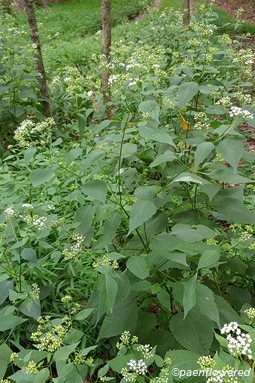
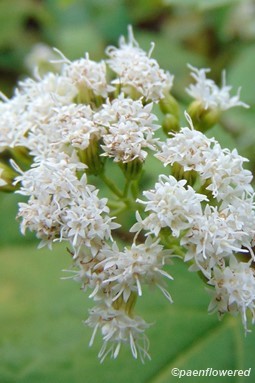
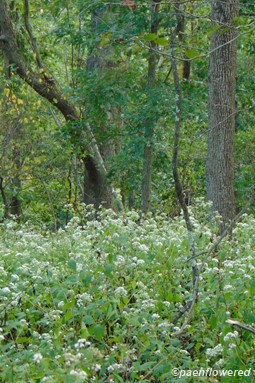

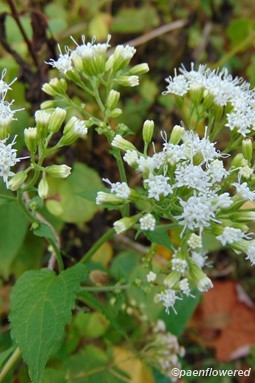
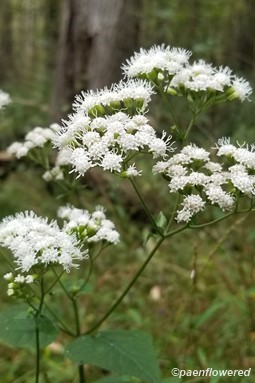



Comments
Have you spotted this plant in your area? We'd love to hear about your experience! Share your comments or questions about the plant below. Comments are moderated before posting.